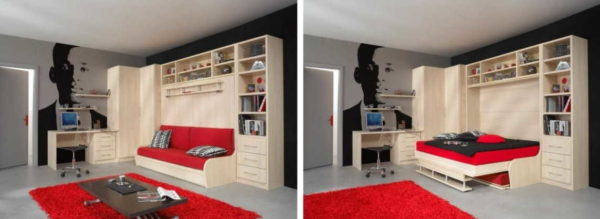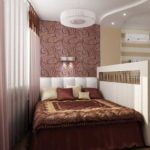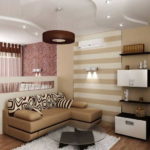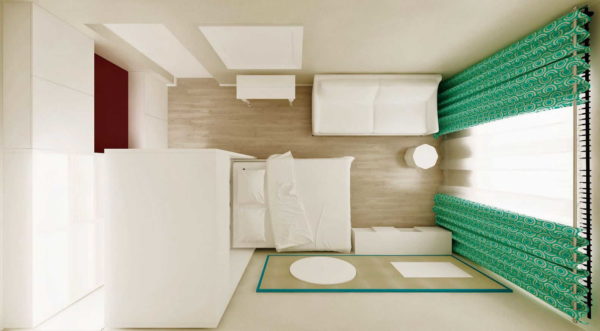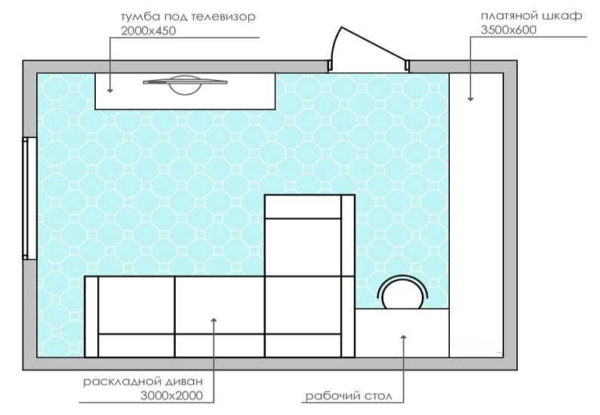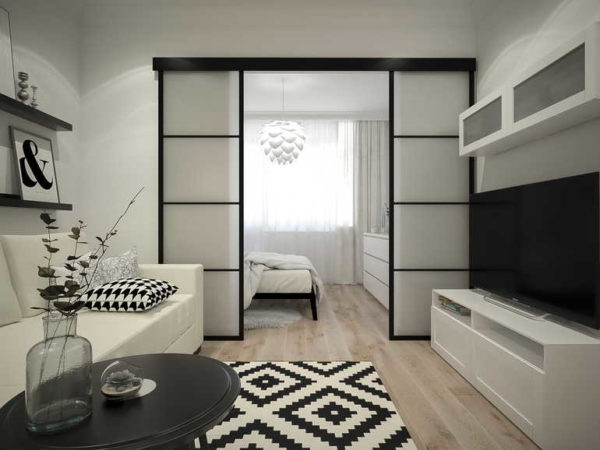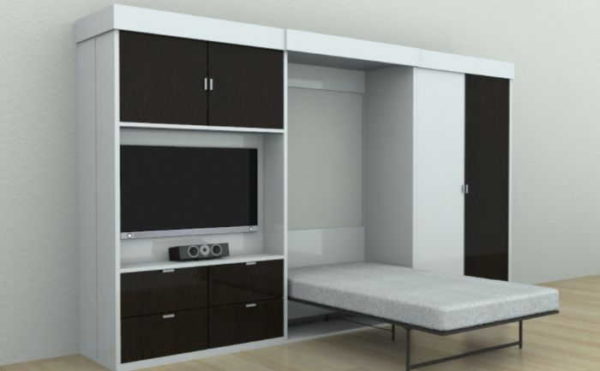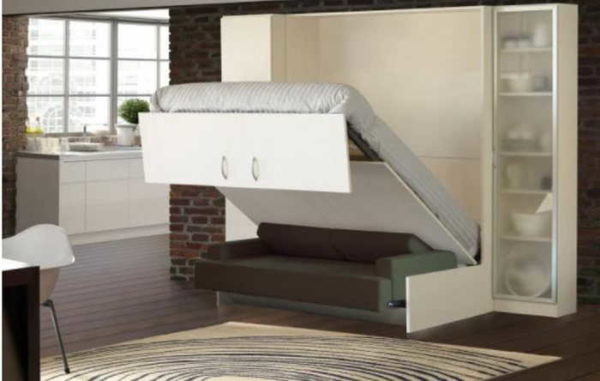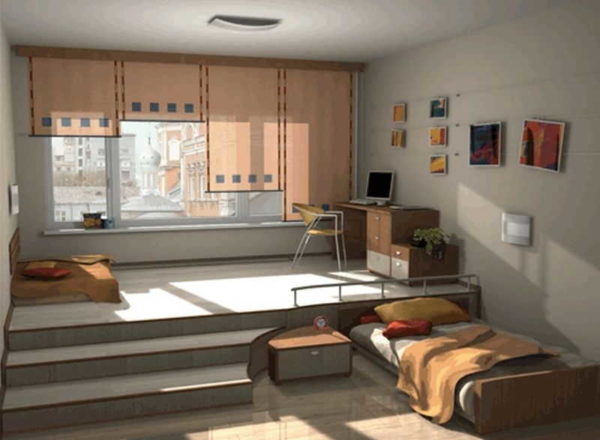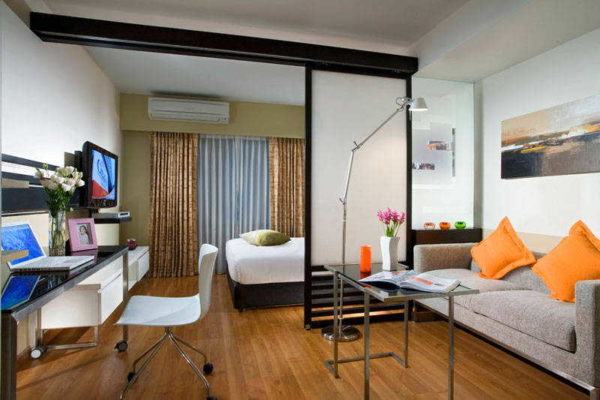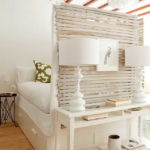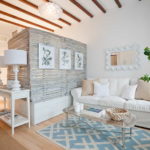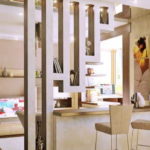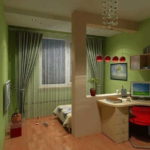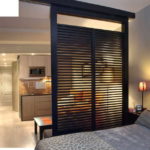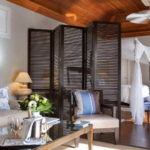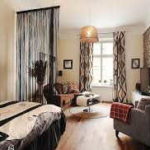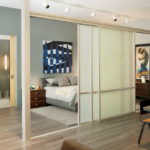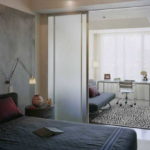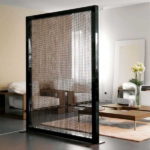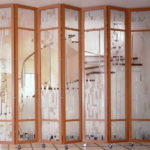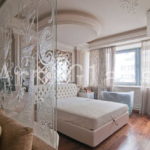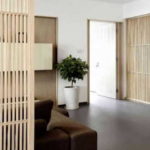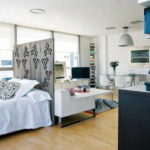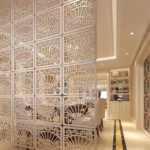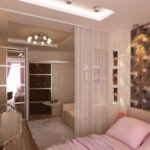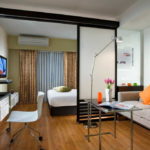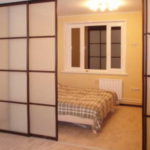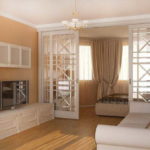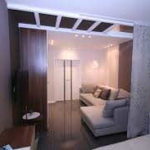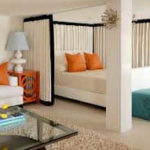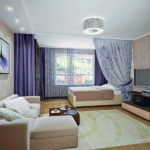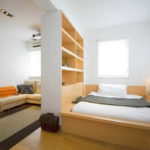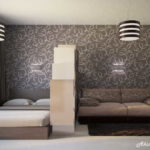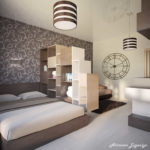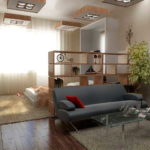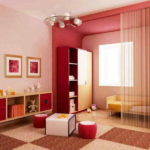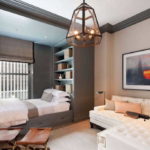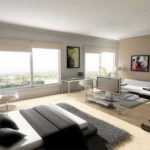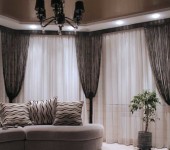How to equip a living room bedroom
Multifunctional rooms allow you to live as comfortably as possible in a small space. One of these possibilities is the living room bedroom. This combination is relevant for studio apartments that are bought by young people or for families who are forced to live in apartments with a small number of rooms. There are enough ways to divide a room into zones to make it comfortable and beautiful.
The content of the article
- 1 How to equip a living room with a sleeping place
- 2 How to divide a room into zones
- 3 Solution for small rooms
- 4 Choose a place for the sleeping area
- 5 Living room-bedroom zoning with partitions
- 6 Separation of zones by screens
- 7 Zoning curtains
- 8 Using furniture for separation
- 9 Living room bedroom: additional zoning techniques
How to equip a living room with a sleeping place
When planning the situation when combining the living room and bedroom, one must proceed from the area of the room. Actually, there are several ways.
- Do not delimit space, but use transformer furniture. In particular, a bed built into a wardrobe or a sofa bed, but not in the old version, but in the new one (one of the examples in the photo).
- Block out the space for the bed by fencing it off with a stationary or sliding partition.
- Separate the bed with a screen or curtains.
- One of the ways to highlight the bedroom area in the living room is a partition, but not in full height
- This is a view from the living room side to the bedroom
- Use furniture (wardrobe, shelves, etc.) for zoning.
If the living room the bedroom is small (less than 16 squares) or it is not possible to install a bed and a sofa due to the peculiarities of the layout, there is only one solution - to use transformer furniture. If space allows, you can use any of the methods.
How to divide a room into zones
To decide whether you can get two separate zones in the room or not, you must first evaluate everything on the plan. This can be done in design programs that allow you to get a two-dimensional or even three-dimensional image. If working with programs does not seem attractive to you, you can get by with two sheets of thick paper or cardboard.
To evaluate zoning options manually, you need a floor plan with dimensions drawn to scale. On it, display where the windows and doors are (also with dimensions). Next, you need to think about where you would like to put the bed, where is the sofa for guests. For the living room-bedroom, these are two key items that they try to put in the first place. It is better to cut them out of cardboard, and also to scale. It will also be necessary to cut out the furniture that is necessary and must be made of cardboard. If you don't already have it, cut it to the size you want. Then you can make adjustments.
The resulting set of "furniture" can be moved around the room plan, finding possible options for the location of zones. If there are several options, sketch, signing where and what you will put, putting down the dimensions of the furniture and the aisles between them. Then it will be possible for everyone to think over which type of zoning can be applied in each option. The program works in approximately the same way, only the movement is virtual. With the help of the program or layouts, you will understand whether you can select two separate zones, while determining the size of each of them. If it is not possible to select separate zones, you will have to do with folding furniture.
Solution for small rooms
The arrangement of small rooms requires a special approach.Interior design is an art, and the design of a small room, and even multifunctional, is generally akin to circus art. Even the little things are important here.
Let's start with what is considered a small room in this case. In general, it is believed that a room with an area of 14-16 meters is rather big. But in the case of the need to place two zones - living room and bedroom - this is really very little. These are the premises - up to 16 squares and we will take them as small. If the area is 18-20 meters or more, these are already "normal" sizes in which the living room and the bedroom can be divided using any zoning techniques.
Using modifiable furniture
In a small area, combining a living room and a bedroom, while placing a full bed, is far from always possible. But you can always put a transformable instead of a regular sofa. This is not the kind of sofa bed on which you can sleep only conditionally. Modern convertible furniture can provide the same level of comfort as a regular stationary bed. There are models with orthopedic mattresses. In width - from single to full double.
Can be converted into a double bed:
- Cupboard. When closed, it looks like an ordinary wardrobe, leans back, it turns out a bed.
- Sofa. This type of furniture in the "daytime" position is similar to a sofa that stands near the closet, in the "nighttime" position - the bed is lowered, crushing the sofa under itself.
The options described above require a free space of at least 220-250 cm in front of the sofa or wardrobe (depending on the model). And even after the bed is in place, at least a narrow passage should remain. So in fact, the distance to the transformable furniture should be at least 280 cm. But you get a full double bed. The mattress can even be orthopedic.
There are also options for single or single beds. In them, the bed base is attached to the furniture with the long side. They require less free space - no more than 200 cm in the case of a one-and-a-half bed or 150 cm in the case of a single bed.
Unusual ways
There is one non-trivial version of how you can highlight the bedroom area in the living room: make a podium, on which to take out some area. There you can place, for example, several armchairs and a coffee table or put a sofa. Move the bed under the podium.
With this solution, the flooring must be of sufficient height so that the bed can be hidden under it. Long and narrow rooms, also called trailers, are ideal for such a solution.
Another option for the young and active is to move the bedroom to the closet. A square or rectangle of sufficient area is assembled from cabinet furniture (high shelves, cabinets) to accommodate a sleeping place on it. You can do this with plasterboard partitions (as pictured). A staircase is built in / attached to one of the sides, along which they climb up to the "bedroom".
It turns out a living room bedroom without reducing the living room area. You can even make the room even more multifunctional: arrange a workplace or a mini-office in a space fenced off by furniture. This is a great option for a small studio apartment where young people live.
All this is good, but it is worth knowing about the shortcomings. First, the solutions are not cheap. Convertible furniture costs a lot, as does the manufacture of a podium with sufficient bearing capacity. Secondly, every evening and every morning, in order to get and hide a sleeping place, you will have to perform certain body movements. It just seems easy at first. In fact, it gets boring pretty quickly ... until it becomes a habit.
Choose a place for the sleeping area
When dividing rooms into a bedroom and a living room, the first step is to decide where you want to make the bedroom. Most often, the corner farthest from the entrance is taken. This makes sense, as the bedroom requires the greatest degree of privacy.
If there is a window in the separation area, you have to take care that there is enough light in the rest of the room. This helps glass partitions, Separation with screens or curtains, specially created translucent shelves.
In the opposite situation - if the window is in the living room area, the situation is somewhat better. First, the bedroom is usually used in the dark. So natural light is not really a necessity. Although we are used to what it should be. There are two solutions: to make the separation so that there is enough light or to get the missing one by installing additional lamps.
Living room-bedroom zoning with partitions
For zoning, partitions made of plasterboard and glass are used. Installation of both is not a redevelopment, so it does not require approval.
Not everyone likes the idea of a room divider. But it may not be whole. Very often, a "monolithic" partition is erected to a height of a meter or a little more, and above they do something delicate, allowing light to pass through. This solves the problem of natural light and the structure does not look as heavy as a wall.
- Partitions - they are different
- Also a good way to separate the bed.
- Openwork things are made of drywall
- It is also an option
The upper part can be decorated in different ways. If you want a physical separation, but without much loss of light, it can be patterned, frosted, colored glass. Don't be afraid that glass partition fragile - it can withstand loads greater than drywall.
Other options: various kinds of wood and metal products. There are a lot of options - from functional or decorative shelves, to simply installed in a certain order (or without it) pins made of wood, metal, bamboo, etc.
Separation of zones by screens
You can make zoning in the living room bedroom using screens. This is a quick and inexpensive way to make living room and bedroom zoning in the same room. Do not think that this method is outdated and irrelevant. If you approach the choice of textures, materials, colors correctly, everything looks very stylish, original and appropriate.
- Option of a translucent partition for zoning the living room of the bedroom
- A portable screen can be stylish
- Even a rope curtain can be used as a screen. The main thing is the visual delimitation of space
- Lightweight movable curtain
- Openwork is good in classic interiors
There are traditional screens - portable, folding. But it is by no means necessary that they have an "old-regime" look. No, traditional-style screens - covered with tapestries - are good for classic interiors. And those that come from the "sixties" - painted, made of wood and plywood - look great in a loft or art deco. If you have a living room, a bedroom is decorated in this style, it is not difficult for you to find the option you need. But for modern interiors, other materials and textures are needed, and here you have to try.
Glass screens
For modern style, minimalism, hi-tech, glass screens are ideal. But the glass must be chosen differently. For hi-tech and minimalism, the best option is tinted with a silver coating, reminiscent of a mirror. White, milky, gray will look good - depending on the design of the bedroom-living room. The Provence style living room bedroom can also be equipped with a painted plywood screen. But if you don't like too "rural" option, you can add a glass screen with a photo print.You can choose one of the landscapes that are typical for the south of France, use colored glass with floral ornaments.
- Frame made of metal, filling - frosted glass or polycarbonate sheet
- Milky glass is opaque, but allows enough light to pass through
- A look from the other side
- An interesting option with patterned glass
- Traditional glass sliding screen
- Patterns applied using a sandblaster
Again, you shouldn't think that glass is fragile. For such products they use hardened or laminated (duplex and triplex), and they are stronger than many sheet materials.
From other materials
If you still don't like glass, you can make or look for partitions made of plastic, wood, etc. A wooden screen can be made into a wooden house. If you know how to work with wood, this will not be difficult, since the design is uncomplicated. You can simulate a wall, you can make a lighter, openwork structure. Again, all the envy of the style in which the living room is decorated, the bedroom.
- A patterned plastic partition visually separates the zones from one another
- The simplest wooden screen made of rods or planks
- Carved wood paneling requires more skill
- Metal openwork….
If wood is only found in some decor items, frames are made from it, and the filling is selected according to your own taste. After all, it could be fabric. Same as on curtains or upholstery. You can use laminated fiberboard to match the furniture, plywood or thin Chipboard... You can even assemble such a screen from drywall and paste over it with wallpaper or paint it - there will be a movable wall.
For a modern style, you can use well-aimed branches, painted in the main or one of the complementary colors. They are attached to the frames along or across, get a translucent screen. Likewise, you can fix bamboo, metal rods, etc. In general, as usual in interior design, this is a creative process.
Sliding screens
A few more words about sliding screens. They are in a separate class, since they are not as "nailed to the spot" as stationary partitions, but also not as mobile as portable screens. A very good option for zoning the living room of the bedroom in one room, if you want to have a secluded corner to relax.
Sliding screens can be of three types. They can move like compartment doors, fold like a book or an accordion. For all, for the bottom, guides are needed that are attached either to the ceiling, or to the floor, or to both the floor and the ceiling at the same time. There can be only screens with a lower guide not to the ceiling, but they are the most unstable. If you have children or are not sure that you will use them carefully, it is better to use floor-to-ceiling models.
- Sliding screens are made as compartment doors
- Living room bedroom with separation of zones using sliding screens
- With a slight touch of oriental style
- Geometry always looks good
Material for screens of this type - any sheet: glass, plastic, laminated fiberboard, MDF. Similar systems can be found in firms dealing with wardrobes. Doors for wardrobes made according to the same system and the partitions are no different.
Zoning curtains
An even more inexpensive way is the living room, the bedroom, divided into zones by curtains. All that is required is to select and fix curtain rods. Then - pick up fabrics and sew panels of the right size. The fabrics are used the same as on the windows and they do not have to be dense, although this option is possible.
- Draperies around the perimeter - to create comfort
- Visual separation
- Double curtains - it is important to choose the right curtain rods
The drapery can only cover the "gap", but it can also go along the walls, creating a cozy atmosphere. But this option will still require enough funds, since a lot of tissue is needed.
Such zoning of the bedroom and living room combined in one room is nominal, but creates the required sense of privacy. It can be used in the version with portable screens, as a temporary option - if you cannot decide exactly where to place the bedroom and living room zones, how to distribute the area between them.
Using furniture for separation
It is not always possible to take even a small piece of space in a small room for a non-functional partition. Moreover, furniture can perform the same task. This is usually a closet or high shelves.
Most often, the lower part of the furniture is made without gaps (about a meter high). I make this part in the form of a cabinet or a chest of drawers. The upper one is usually done with through gaps. So the furniture does not look so bulky and does not "load" the space. In addition, this solution allows you to maintain natural light in both parts of the room.
- A cabinet or chest of drawers is made at the bottom, shelves above
- Non-linear shape adds originality
- A look from the other side
- The main thing is not to clutter the shelves.
When developing a concept for such furniture or looking for ready-made options, keep in mind that all horizontal surfaces are excellent at collecting dust. Each shelf is a dust collector. If they are not planned to be used, it is better to make as few contours as possible. It is better to hang a few decorative items in the intervals between the racks. They collect much less dust, and they look, perhaps, more original.
Living room bedroom: additional zoning techniques
In addition to physical separation, the zoning of the living room-bedroom in one room can be carried out using:
- Changes in floor and ceiling levels. For example, the bedroom area can be raised slightly, and different flooring can be used to accentuate the division even more. It can be the same color, but different in texture or material. For example, in the living area lay the laminate, in the bedroom area - carpet. You can also use different colors.
- Different wall colors are one of the zoning tools. So the living room bedroom clearly has two parts that are different in purpose.
- Color separation
- The podium is rather big ... but it can be 5-10 cm high
- Decorate the walls in different colors. You can use wallpaper of two colors, but with the same texture, paint in a different color, etc.
- Different texture of the walls. In the living room, for example, a decorative Venetian type plaster, in the bedroom - liquid wallpaper.
These tricks, along with separators, emphasize the different purpose of the zones. But when choosing colors you need to be guided principles of color compatibility. Then it will turn out to create a harmonious interior.

